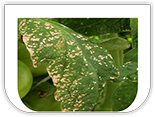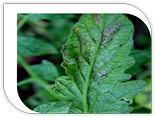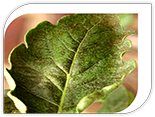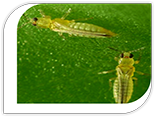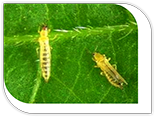 Crops: Tomato Insect Pests
Thrips - Frankliniella occidentalis
Crops: Tomato Insect Pests
Thrips - Frankliniella occidentalis
- Thrips are tiny (1/16 inch), slender insects that vary in color from yellow or orange (most common color) to dark brown or black.
- Thrips overwinter in plant debris or on weeds.
- They prefer to feed in flowers but also occur in flower and leaf buds and, occasionally, on leaves. They are more likely to be found on leaves of vegetables early in the season when these leaves have pine pollen on them. Thrips then feed on this pollen.
- There are two larval stages and a pupal stage. Immature thrips are sometimes transparent and take on the appearance of whatever plant part they are on, which can make them almost impossible to see even with a 10x hand lens.
- Thrips have only the left mandible and use this mouthpart to punch a hole or scrape the leaf surface of the plant disrupting cells and feeding on the cell contents. This feeding method damages tomatoes in several ways.
- Feeding in blossoms may cause blossom drop, or fruit may not develop properly and become deformed. Feeding on foliage may cause a bronzing or silvering of foliage.
- Infected plants have dark lesions on the foliage and fruit show characteristic halo markings. If plants are infected early in the season they remain small and never produce a crop. If infected later in the season fruit often becomes unmarketable.
- Only immature thrips can acquire the virus when they feed on an infected plant, adults cannot, but only adults can vector the virus to another plant.
- To determine thrips presence; sample 20-40 flowers while scouting. Thrips will be visible inside the flower using a 10x hand lens.
- The recommended thrips treatment threshold is five thrips per flower.




